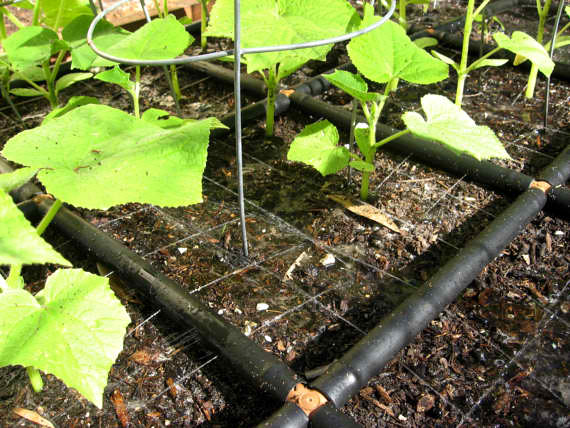There are a lot of benefits to growing in raised beds, but like any other way of growing veggies outdoors, keeping it watered properly can become an issue. Something anyone with a hectic week in the hottest part of the summer has discovered. This is especially true when the raised bed has a barrier between ground soil below, or is sitting on a paved surface where no wicking up of deeply stored moisture is possible.
Relying on that nifty looking old watering can, or the spray nozzle on the end of the hose means you have to have time to irrigate your plants when they need it. With a timer that costs less than $20 you can rig up a sprinkler or drip hose to make sure that your veggies get watered regularly. But then you have to make sure that the wind doesn’t shift the spray and waste the water, which is impossible if you’re not there to move the sprinkler. Drip hoses are better, but you have to engineer your layout to deliver moisture evenly…
So you stand in the yard and garden department, or the plumbing department at the big box home improvement store wondering what parts will make your garden happy and your life less hectic. Its a lot easier in a large garden than a small one like a raised bed, because you have less connections to worry about.

Of course, you could take the easy route and just buy everything, but that won’t give you home grown flavor, and certainly no sense of accomplishment. Or you could take advantage of the savvy engineering brought to you by Garden In Minutes. They’ve devised the perfect drip irrigation system for raised bed gardening, and the only parts needed from that massive home improvement center is a timer to turn the water on and off for you. Perhaps a hose to connect the water to the drip system, and a splitter valve for the spigot too. If you use the faucet for something else and forget to hook the irrigation line back up — you’re back to square one.
It’s called the Garden Grid, and was designed by square foot gardeners to fit the popular 4′ x 4′ raised bed, but is available in a range of sizes from 2′ x 2′ to 4′ x 6′. They can also be connected to each other, so an assortment of sizes will give you the perfect arrangement for watering any size raised bed – even a small in-ground garden. Not only does it relieve you from daily watering duty, it doesn’t rain down on the foliage like the hose sprayer or sprinkler does, alleviating plant diseases so common in veggies like tomatoes from overhead irrigation. Drip irrigation soaks in, so no precious water is wasted to run-0ff.
If you don’t have a raised bed yet, no problem. They sell full kits at Garden In Minutes that come with the Garden Grid, and all you have to do is fill it with soil and plant. That’s their Horseshoe Kit above. It comes with everything you need, including hoses, a timer, and a 2-way valve splitter. The only thing you’ll need from the garden center is your growing media. Their raised beds are solidly constructed of 1 3/4″ thick cedar boards.
 You can tell that they’ve been at this for a while by the design of the Garden Grid. Before you run off to the local do-it center to cobble your own together, consider the time involved in building this system, and the fact that if it isn’t done right it will not be very sturdy. Check out the fine nylon grid that ensures the multiple sections stay in shape and secures the grid in this closeup image. Smart design. If you tried this with average hose repair parts, you’d have more fittings than water delivery area… I’m sure they started that way.
You can tell that they’ve been at this for a while by the design of the Garden Grid. Before you run off to the local do-it center to cobble your own together, consider the time involved in building this system, and the fact that if it isn’t done right it will not be very sturdy. Check out the fine nylon grid that ensures the multiple sections stay in shape and secures the grid in this closeup image. Smart design. If you tried this with average hose repair parts, you’d have more fittings than water delivery area… I’m sure they started that way.
Memories of sad homemade irrigation systems come to mind. Especially the time that an entire Sunday was spent engineering one for the entire dooryard garden, and when it was all in place we discovered that there wasn’t enough water pressure to run it. 🙁
Get more info at Garden In Minutes.
Hi Amber,
Great post! Thank you for your interest! If you have any questions feel free to reach out.
Happy Gardening,
Bryan
GardenInMinutes.com
Hey Bryan – glad to see you dropped by GC.